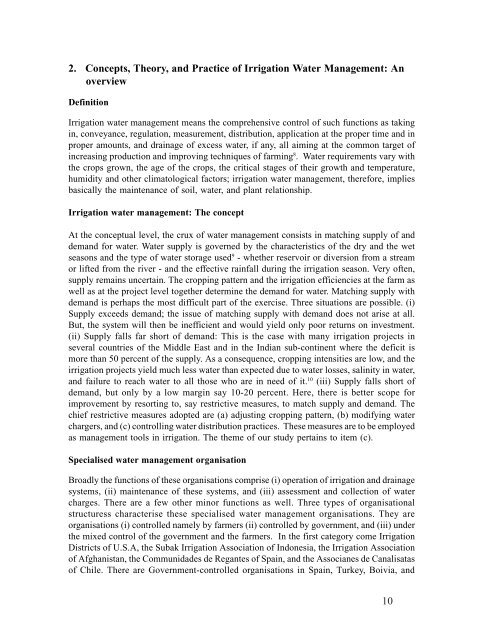Beneficiary Participation in Irrigation Water Management: The Kerala
Beneficiary Participation in Irrigation Water Management: The Kerala
Beneficiary Participation in Irrigation Water Management: The Kerala
You also want an ePaper? Increase the reach of your titles
YUMPU automatically turns print PDFs into web optimized ePapers that Google loves.
2. Concepts, <strong>The</strong>ory, and Practice of <strong>Irrigation</strong> <strong>Water</strong> <strong>Management</strong>: An<br />
overview<br />
Def<strong>in</strong>ition<br />
<strong>Irrigation</strong> water management means the comprehensive control of such functions as tak<strong>in</strong>g<br />
<strong>in</strong>, conveyance, regulation, measurement, distribution, application at the proper time and <strong>in</strong><br />
proper amounts, and dra<strong>in</strong>age of excess water, if any, all aim<strong>in</strong>g at the common target of<br />
<strong>in</strong>creas<strong>in</strong>g production and improv<strong>in</strong>g techniques of farm<strong>in</strong>g 8 . <strong>Water</strong> requirements vary with<br />
the crops grown, the age of the crops, the critical stages of their growth and temperature,<br />
humidity and other climatological factors; irrigation water management, therefore, implies<br />
basically the ma<strong>in</strong>tenance of soil, water, and plant relationship.<br />
<strong>Irrigation</strong> water management: <strong>The</strong> concept<br />
At the conceptual level, the crux of water management consists <strong>in</strong> match<strong>in</strong>g supply of and<br />
demand for water. <strong>Water</strong> supply is governed by the characteristics of the dry and the wet<br />
seasons and the type of water storage used 9 - whether reservoir or diversion from a stream<br />
or lifted from the river - and the effective ra<strong>in</strong>fall dur<strong>in</strong>g the irrigation season. Very often,<br />
supply rema<strong>in</strong>s uncerta<strong>in</strong>. <strong>The</strong> cropp<strong>in</strong>g pattern and the irrigation efficiencies at the farm as<br />
well as at the project level together determ<strong>in</strong>e the demand for water. Match<strong>in</strong>g supply with<br />
demand is perhaps the most difficult part of the exercise. Three situations are possible. (i)<br />
Supply exceeds demand; the issue of match<strong>in</strong>g supply with demand does not arise at all.<br />
But, the system will then be <strong>in</strong>efficient and would yield only poor returns on <strong>in</strong>vestment.<br />
(ii) Supply falls far short of demand: This is the case with many irrigation projects <strong>in</strong><br />
several countries of the Middle East and <strong>in</strong> the Indian sub-cont<strong>in</strong>ent where the deficit is<br />
more than 50 percent of the supply. As a consequence, cropp<strong>in</strong>g <strong>in</strong>tensities are low, and the<br />
irrigation projects yield much less water than expected due to water losses, sal<strong>in</strong>ity <strong>in</strong> water,<br />
and failure to reach water to all those who are <strong>in</strong> need of it. 10 (iii) Supply falls short of<br />
demand, but only by a low marg<strong>in</strong> say 10-20 percent. Here, there is better scope for<br />
improvement by resort<strong>in</strong>g to, say restrictive measures, to match supply and demand. <strong>The</strong><br />
chief restrictive measures adopted are (a) adjust<strong>in</strong>g cropp<strong>in</strong>g pattern, (b) modify<strong>in</strong>g water<br />
chargers, and (c) controll<strong>in</strong>g water distribution practices. <strong>The</strong>se measures are to be employed<br />
as management tools <strong>in</strong> irrigation. <strong>The</strong> theme of our study perta<strong>in</strong>s to item (c).<br />
Specialised water management organisation<br />
Broadly the functions of these organisations comprise (i) operation of irrigation and dra<strong>in</strong>age<br />
systems, (ii) ma<strong>in</strong>tenance of these systems, and (iii) assessment and collection of water<br />
charges. <strong>The</strong>re are a few other m<strong>in</strong>or functions as well. Three types of organisational<br />
structuress characterise these specialised water management organisations. <strong>The</strong>y are<br />
organisations (i) controlled namely by farmers (ii) controlled by government, and (iii) under<br />
the mixed control of the government and the farmers. In the first category come <strong>Irrigation</strong><br />
Districts of U.S.A, the Subak <strong>Irrigation</strong> Association of Indonesia, the <strong>Irrigation</strong> Association<br />
of Afghanistan, the Communidades de Regantes of Spa<strong>in</strong>, and the Associanes de Canalisatas<br />
of Chile. <strong>The</strong>re are Government-controlled organisations <strong>in</strong> Spa<strong>in</strong>, Turkey, Boivia, and<br />
10










